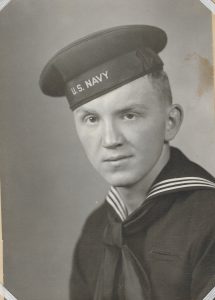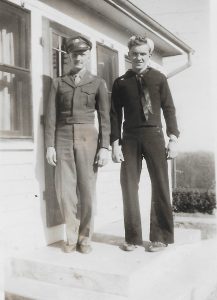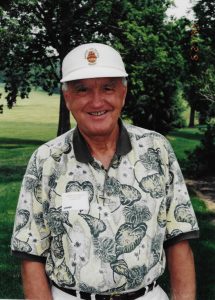Long before Al Terpstra, 91, of Lynnville owned and operated the Lynnville Seed Company and served as an elected official in the community of Lynnville, he served our country in the United States Navy Air Force at the end of World War II.
In 1944, Terpstra graduated from high school and set his sights on serving his country by joining the military. Living in Lynnville with his family who operated the Lynnville Seed Company, Terpstra volunteered for the U.S. Navy Air Force in the summer of 1944, but it wasn’t until January 1945 before he actually reported for duty. “I was ready to go,” Terpstra said, recalling his disappointment and frustration at the amount of time it took for him to become an active service member.
After six weeks of boot camp in Memphis, TN, Terpstra began his training to become a Combat Air Crew Navy Torpedo Bomber, which included duties as both radio operator and gunner. His radio operator training took him to the Naval Air Technical Training Center (NATTC) in Millington, TN, near Memphis for 20 weeks. There, Terpstra acquired the skills to become proficient at radio operation in sending and receiving Morse code (a system of a series of "dots" or “dits” of short duration and "dashes" or “dahs” of longer duration, which are combined into a standardized recognizable form representing letters, numbers, and special punctuation).

Terpstra in his Navy Seaman dress blues.
Terpstra was also trained in the use of the semaphore flag signaling system, which is a means of conveying letters of the alphabet and numbers for viewing from a distance by waving a pair of hand-held flags (usually square, and divided diagonally with a red triangle occupying the upper and staff edges, and a yellow triangle along the lower and outer edges). The flags are briefly held in a specific position with one’s arms extended for a short time, signifying a letter of the alphabet or a number.
The second part of Terpstra’s training was dedicated to acquiring the skills needed to become a gunner. For the Navy planes on which he received training, the crew consisted of only two people, the pilot and the radio operator/gunner. The types of planes for which Terpstra was being trained were Navy torpedo bombers and dive bombers. He recalled two of these types of planes were the carrier-based fighter aircraft “Grumman F6F Hellcat” and the carrier-based dive bomber “Curtiss SB2C Helldiver.” To receive his gunnery training, Terpstra was sent to Naval Air Station (NAS) Cecil Field in Jacksonville, FL, in October 1945.
But by the time Terpstra had begun his gunnery training, a major shift had taken place in the war, as both Germany and Japan had already surrendered to the Allied Forces by September 1945, and the mission of the Navy Air Force had been changed. After completing his gunnery training in March 1946, Terpstra was sent to NAS Anacostia in Washington, D.C., where a naval reserve unit was then based.
Because of the war’s status at the time Terpstra had completed his radio operator and gunner training, he was not able to utilize his training in an actual combat situation. “The Navy had to figure out what to do with us,” Terpstra said, referring to himself and multitudes of other members of the Navy whose plans had been changed after the surrender of Japan. Each of these people had to accumulate a certain number of points (correlating to time of military service) before they could be discharged. When these men enlisted in the military and committed their lives to serving their country, none of them would have known that the end of the warfare would be attained in a matter of months from their enlistment. And as a result, Terpstra was among those who would spend their entire naval enlistment time on land.
However, never being one to sit idly by, Terpstra preferred to keep busy and approached his supervisor at Anacostia about giving him a job, something to do. At the NAS, the reserve pilots were required to periodically log a certain number of hours in the air to retain their reserve status, and Anacostia served those needs well. The reserve unit at the NAS needed personnel to service the planes they flew for logging their flight hours, and Terpstra was happy to serve as part of the service crew, performing various duties such as gassing planes before flight.

Albert Terpstra, on the right, with his brother Arnold who enlisted in the U.S. Army.
Before Terpstra received his honorable discharge in August 1946, he was visited by his brother Arnold (Arnie) Terpstra, who had just graduated from high school and would soon be reporting for duty with the U.S. Army. Arnold wanted to see New York City before he was sent to basic training, and the brothers set off for an adventure in the Big Apple on Al’s weekend pass. They left Anacostia early in the morning, and hitchhiked from Washington, D.C., through Baltimore and finally to New York City, all in a day. Arnold was still a civilian at this point, but Al wore his Navy uniform that day, which came in handy when looking for a ride.
“Everyone hitchhiked in those days,” Terpstra recalled, “even from Lynnville to Sully.” The Terpstra brothers arrived in New York with enough time to spare to enjoy themselves at the Coney Island amusement park and then stayed a night in the cheapest hotel they could find. For the end of their journey, they saved $3 apiece for a train ride back to Washington, to give their thumbs a rest!
After attaining the rank of Seaman 1st Class, Terpstra received his honorable discharge from the Navy in August 1946 and returned home to Lynnville. When Arnold was discharged from the Army in 1948, he also returned to Lynnville, and together the brothers took over the seed company business from their father.
Al’s desire to serve continued in the community of Lynnville, where he served as mayor and councilman and was instrumental in developing the Lynnville Ballpark, where Al Terpstra Field now sits. For committing himself for our country over 70 years ago, and later within our corner of Jasper County, our community thanks Al Terpstra for his service.

Terpstra’s desire to serve extends well beyond his Navy experience as he has been a leader in the community for decades.



